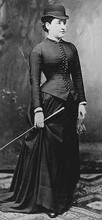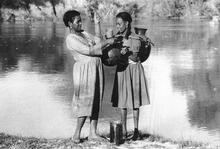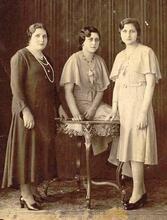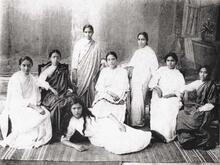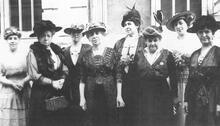Jewish Migrations to the United States in the Late Twentieth Century
The three primary groups of Jewish immigrants to the United States in the last decades of the twentieth century were from the former Soviet Union, Israel, and Iran. The vast majority of female Soviet immigrants worked, but they experienced high levels of personal discontent. Unlike Soviet women, female Israeli immigrants usually felt isolated, worked less, and often left Israel at the behest of their husbands. Due to the political climate in Iran, Jewish immigrants from that country emigrated to live permanently in the United States, which led many women to form cultural and religious groups that helped sustain communal ties. In each group, women played key roles in helping their communities adapt to life in the United States.
Soviet Emigration
Editor’s Note: In 1991, with the collapse of the Soviet Union, this political entity was replaced by the Commonwealth of Independent States (CIS), also known as the former Soviet Union (FSU). References in this article to “Soviet Jews” refer to Jews from both the USSR per se (before 1991) and its component republics (after 1991).
In the largest Jewish immigrant wave since the 1920s, nearly three hundred thousand Soviet Jews settled in the United States after 1970. More than two-thirds of all Jewish immigrants to the United States since 1980 have been from the (former) Soviet Union. Women, who comprised fifty-three percent of those who arrived during the wave’s peak, between 1970 and the 1990s, came to the United States with an unusually high degree of professional and technical skills.
In contrast to the 16.5 percent of American women who worked as engineers, technicians, or other professionals, over two-thirds of Soviet Jewish émigré women had worked in these occupations prior to their arrival. As is consistent with their occupational status, these Soviet Jewish women immigrants were also highly educated. Their average number of years of schooling was 14.2. Despite their high degree of educational and occupational attainment, women’s salaries in the USSR were only fifty-seven percent of those of men.
Due to economic need, as well as to a cultural expectation that women work, more than sixty percent of Soviet Jewish émigré women held full-time jobs in the American labor force in 1980. The types of jobs women received were different from those of their male counterparts. Thirty-eight percent of working women held managerial, professional, or technical positions, compared with sixty-nine percent of men. Another thirty-one percent of the women émigrés were employed in clerical and sales jobs, compared with just seven percent of Soviet Jewish male immigrants.
Similar to their experience in their country of origin, Soviet Jewish women’s earnings in the United States remained fifty-seven percent of those of their male counterparts, a proportion only slightly below that of American women’s earnings relative to those of men. Despite these income disparities and their lower job statuses than the ones they had in the USSR (or FSU), 42.5 percent of Soviet Jewish women (versus 35.4 percent of men) were very satisfied with their work, and another 40.2 percent (versus 51.1 percent of men) reported being somewhat satisfied.
In addition to being satisfied with work, surveys show that Soviet Jewish women émigrés were content with other economic features of their new country. In the United States, they attained better housing, higher incomes, and an overall higher standard of living than in the Soviet Union. They also reported being satisfied with the Jewish component of their lives. Life in the United States is less dominated by antisemitism than in their former home.
In other realms, however, Soviet Jewish women immigrants found the quality of their lives deficient. Compared with the Soviet Union, most female Jewish immigrants found life in the United States to be less emotionally and intellectually fulfilling. They perceived cultural life as thinner in the United States, friendships as weaker, and their social status as lower. Their departure from their homes, then, was not motivated by discontent in their personal lives. Rather, antisemitism, combined with a desire to seek occupational and educational opportunities for themselves and their children, led the great majority of the Jewish émigré women, as well as men, to leave the USSR.
Detailed observations reveal another source of discontent among Soviet Jewish women immigrants. Although the majority of Soviet émigrés are still part of two-income families, evidence suggests that upwardly mobile men increasingly pressured their wives to leave the labor force, undermining Soviet Jewish women’s triple role as wife-mother-worker. Working had been such an integral part of Soviet Jewish women’s identities that female émigrés were surprised when, upon their arrival, their social workers did not automatically expect them to work.
As wives and mothers, Soviet Jewish women tend to have smaller families than the norm, with an average of 1.4 children (the U.S. average is 2.1), although they are likely to marry at a younger age than women of other ethnic groups. Demographic data released in 2004 indicate that Russian-speaking women in the United States are marrying more rapidly, at an earlier age and in greater numbers than most other women. Only four percent of forty-year-old women born in the FSU had never married, compared with fifteen percent for all women of that age.
A study begun in 1998 found that eighteen to thirty-two-year-old Russian-Jewish women in the New York metropolitan area married earlier than any other group of women surveyed, while another study showed that half of Russian-speaking women were married by age twenty-two (the average age for women’s first marriage in the United States is 25.3). The important role family plays in the lives of women from the former Soviet Union is reflected also in their immigration patterns: they often immigrate as part of extended families that include three generations. As a result, a high proportion of Soviet Jewish émigré families are multigenerational and include a very elderly population. Settling in the United States with elderly parents and grandparents is one sign of the permanent character of the Soviet Jewish immigration.
Israeli Emigration
In contrast to Soviet Jews, most of the 90,000 Israeli Jews who reside in the United States view themselves as sojourners. Most Israeli women did not want to leave their homes, and their refusal to assign a definition of permanence is one way to cope with the immigration decision.
Unlike Soviet Jewish women who see immigration as a way to improve their own lives, Israeli Jewish women, whether married to Israelis or Americans, place the onus of the immigration decision upon their husbands. For those married to Israeli men, they claim that they came to the United States because of their husbands’ economic and educational goals, thus seeing themselves as adjuncts, rather than as active participants in their families’ immigration decision. Israeli women married to Americans rationalize that for the sake of keeping their marriages intact, they had no choice but to follow their husbands back to the United States.
The perceived lack of responsibility and choice has shaped Israeli women’s immigrant experiences in the United States. Often feeling wrenched away from families, friends, and jobs, Israeli women, particularly those married to Israelis and who have young children, suffer from homesickness and isolation in the United States. While their husbands develop social networks through work and school, the women often remain isolated at home, caring for their children in a new and unfamiliar environment.
Further compounding their isolation, a high percentage of female immigrants who had worked in Israel are not working in the United States. A survey of naturalized Israelis who live in New York reveals that only four percent of the women listed “housewife” as their occupation in Israel, while over one-third of the women indicated “housewife” in the United States. And many of those women who worked in the United States did so only part-time. Compared with Israeli men, Israeli women are more dissatisfied with America and less identified with their new country.
Although a large percentage of Israeli immigrant women are homemakers, a much larger percentage have entered the paid labor force. According to 1990 census data, half of Israeli women in New York, and fifty-nine percent of their Los Angeles counterparts, are employed. Of employed Israeli women in New York between the ages of twenty-five and sixty-four, twenty-three percent are managers and administrators, thirty three percent work in either professional or technical fields, eleven percent are in sales, twenty percent are in clerical jobs, and sixteen percent are self-employed. Nearly one-third of Israeli women in Los Angeles (versus forty percent of men) have four or more years of college. Israeli women are a highly educated and skilled group.
In both New York and Los Angeles, Israeli women are nearly twice as likely as Israeli men to be in professional and technical jobs. In New York, slightly more than one-third of the women are in these fields, compared with seventeen percent of the men. On the West Coast, forty-one percent of the women are employed in professional or technical jobs compared with just twenty-one percent of the men. The overrepresentation of women in this category is probably due to the large number of Israeli women employed as Hebrew school teachers, as well as other types of professionals (e.g., mental health workers) within Jewish agencies.
Living in neighborhoods with other Israelis, meeting other Israeli women, and joining communal organizations offer emotional relief. In Los Angeles, for example, Israeli women become involved with Tzofim (Israeli Scouts), the AMI School (for learning Israeli Hebrew), as well as Israeli-oriented chapters of American Jewish organizations such as the Jewish Federation’s Israeli Division, the Jewish Community Center’s Israeli Program, the Hebrew-speaking chapter of B’nai B’rith, an Israeli chapter of WIZO (Women’s International Zionist Organization), and ORT (Occupational Training and Rehabilitation). Other Israeli women in Los Angeles add synagogues to their organizational repertoire. Finding strategies for maintaining a Jewish identity for themselves and their families, either through secular activities with a national focus or through religious institutions, is a priority.
Iranian Emigration
After the fall of Iran’s Shah Riza Pahlevi in 1979, many Iranian Jews left their homeland for the United States, settling primarily in Los Angeles and New York. This was a permanent migration characterized by entire families moving to the United States.
In the United States, Iranian Jewish women have increasingly entered their ethnic economy through businesses that are operated both in and outside of their homes. According to ethnographic research, Muslim Iranian women are frequent customers of stores and businesses run by Jewish Iranian women, and Jewish women buy at Muslim women’s shops as well. The sharing of many cultural traditions, including particular culinary predilections, has created new avenues of social interaction between these two groups of female immigrants. In Los Angeles, for example, Jewish and Muslim women participated together in building an elderly day center during the 1980s. In contrast to the American setting, Jewish women in Iran were more likely to confine their social interactions to the Jewish world.
Since their arrival in the United States, Iranian Jewish women have become involved with a variety of gender-specific organizations. In Los Angeles, women belong to Iranian chapters of national Jewish organizations such as Hadassah, Women’s American ORT, and Pioneer Women, as well as to synagogue sisterhoods. In addition, they founded the Iranian Jewish Women’s Organization of Los Angeles in 1976, an organization that traces its roots to a 1947 women’s organization in Iran. Among its many activities, the Iranian Jewish Women’s Organization provides student loans, hosts lectures, raises money for Israel, gives an annual “Best Mother” award, and serves as a general philanthropic agency.
All Jewish immigrants to the United States, whether from the former Soviet Union or elsewhere, share certain common characteristics. Immigrant Jewish populations of every origin are far less likely than their American-born counterparts to be divorced (five percent vs. eleven percent respectively). In addition, while immigrants to America have generally been disproportionately male, reflecting a traditional pattern in which men would come to a new country first, find employment and then send for their families to join them, Jewish immigrants to America are much more likely to have come in gender equivalent proportions.
This trend has continued in contemporary migrations, with immigrant women arriving since 1980 in proportions (forty-eight percent of FSU immigrants and forty-nine percent of other immigrant groups) only slightly below their composition in American Jewry as a whole (where women are a slight majority, constituting fifty-two percent of the overall adult Jewish population). Through their wage-earning and domestic duties, these Jewish women play central roles in shaping their group’s adaptation to the United States. They contribute financially to their family economies, retain primary responsibility for managing their homes and for child rearing, and are central actors in the communal realm.
Bellafante, Ginia. “An Immigrant Group in a Rush to Marry Young.” New York Times, December 13, 2004: A1.
Collins, Beth, et al. “Family and Community Among Iranian Jews in Los Angeles.” M.A. thesis, Hebrew Union College–Jewish Institute of Religion, Cincinnati, Ohio (1986).
Dallalfar, Arlene. “Iranian Immigrant Women in Los Angeles: The Reconstruction of Work, Ethnicity, and Community.” Ph.D. diss., University of California, Los Angeles (1989).
Gold, Steven J. “Gender, Immigration and Social Capital Among Israelis in Los Angeles.” Diaspora 4, no. 3 (1995): 267–301, and “Soviet Jews in the United States.” AJYB 94 (1994): 3–57.
“Jewish Immigrants in the United States.” Report 7 of National Jewish Population Survey. United Jewish Communities: The Federations of North America (2000).
Lipner, Nira H. “The Subjective Experience of Israeli Immigrant Women: An Interpretive Approach.” Ph.D. diss., George Washington University (1987).
Markowitz, Fran. A Community in Spite of Itself: Soviet Jewish Emigres in New York (1993).
Simon, Rita James, Louise Shelley, and Paul Schneiderman. “The Social and Economic Adjustment of Soviet Jewish Women in the United States.” In International Migration: The Female Experience, edited by Rita James Simon and Caroline Brettell (1986).

